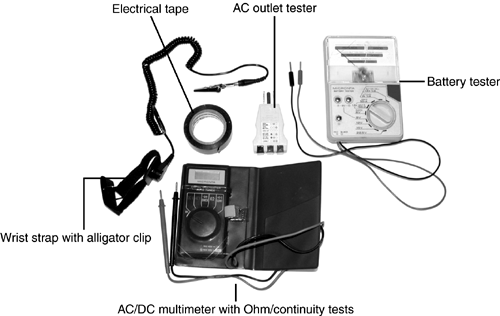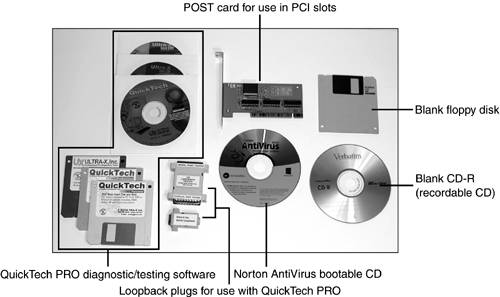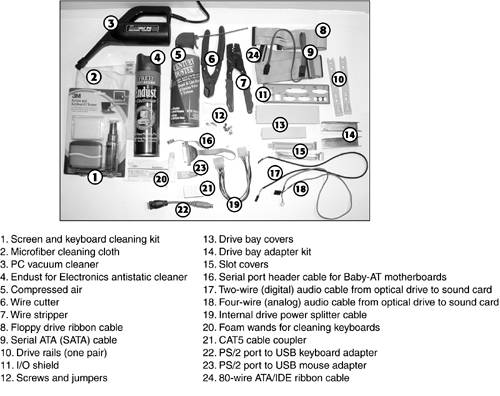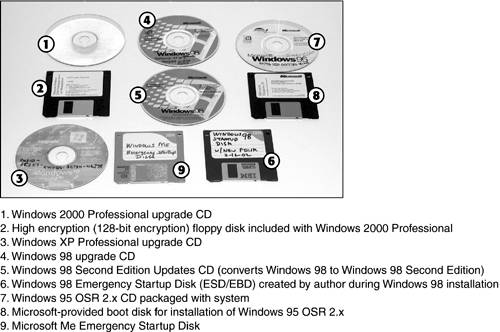| The A+ Certification Exam's troubleshooting content expects you to know the use of basic diagnostic devices, so a review of this section will be useful before your exam. The following list of items also provides you with a handy reference for what you should bring on service calls. Tools The following tools should be a part of every technician's toolkit. You can buy tool-kits that contain many of these items, but don't hesitate to supplement a kit you already have with additional items from this list or other items you find useful. Figure 22.1 illustrates many of these tools. -
Hex drivers ” Use for opening and closing cases and securing and removing cards and motherboards; non-magnetic preferred. -
Phillips and straight- blade screwdrivers ” Use if hex drivers are not compatible; non-magnetic preferred. -
Torx drivers ” Required for some Compaq models; non-magnetic preferred. -
3-claw parts retrieval tool ” Retrieves loose parts from computer interior; prevents lost parts, which can lead to dead shorts if not located. -
Hemostat clamps ” Superior replacement for tweezers for insertion and removal of jumper blocks and cables. -
Needle-nose pliers ” Straightens bent pins. -
Eyebrow tweezers ” Replaces normal tweezers in toolkit for removing and replacing jumpers . -
Penlight ” Illuminates dark cases. -
Magnifier ” Makes small parts and markings easier to read. -
Jeweler's screwdriver set ” Enables repairs to devices that use small screws . Figure 22.1. Typical tools used by computer technicians.  Power Diagnostics, ESD, and Safety The following items enable you to perform electrical testing on power entering the system (AC) and power levels inside the system (DC), prevent ESD damage to components , and prevent electrical shock caused by worn insulation on power cables. Figure 22.2 shows most of these products. -
AC/DC multimeter with Ohm and Continuity options ” Tests power inside system and at wall outlets. -
Grounded AC circuit tester ” Fast testing for wall outlets; many offices and homes are incorrectly wired, and the tester will help you determine whether this is the problem. -
Antistatic mat and wrist strap ” Prevents ESD, which can damage parts and systems. -
Electrical tape ” Temporarily repairs worn spots in the insulation of AC and DC power cables until replacements can be obtained. -
Battery tester ” Helps determine the condition of batteries used in motherboards and other components. Figure 22.2. ESD, electrical, and safety products used by computer technicians.  Hardware Diagnostics Hardware diagnostics tools can help you determine what components inside of a bootable system are not working correctly. Testing software used as part of the diagnostic process can also be used to perform burn-in tests on new hardware to help find problems before systems are put into service. Figure 22.3 shows some typical products. -
Testing software, such as CheckIt Professional Edition (www.smithmicro.com), AMIDiag Suite (www.amidiag.com), or Ultra -X QuickTech Personal or PRO (www.ultra-x.com) ” Tests RAM, hardware configuration, motherboards, serial ports, parallel ports, and drives . caution  | If the testing software you choose doesn't include these, make sure you use compatible loopback plugs. (These can be ordered from the software vendor or various online or mailorder hardware vendors .) Mixing and matching loopback plugs and testing software can provide inaccurate results because different brands of testing programs use various wiring designs for their loopback plugs. |
-
Serial and parallel loopback plugs designed for hardware diagnostics software ” These "loop back" plugs transmit lines to receive lines during diagnostic testing. -
POST card ” Displays hex POST codes during system startup to find boot errors that don't have matching beep codes. -
IRQ/DMA card ” Lights on card display IRQ and DMA channels in use; especially helpful for systems that don't support PnP devices. A single card can include both POST and IRQ/DMA functions. -
Blank floppy disk and CD-R disc ” These can be used to transfer drivers from a working machine to a similar machine that is not working. -
Virus-scanning software ” An up-to-date copy of a major antivirus program such as Norton (www. symantec .com) or McAfee (www. mcafee .com) helps find and remove viruses and Trojan Horse programs that affect systems. If you don't have a licensed antivirus program available to scan a system, but it has a working Internet connection, use the free HouseCall service from Trend Micro (housecall.trendmicro.com) to scan the system. Figure 22.3. Typical hardware diagnostic tools.  tip  | Although many antivirus programs are shipped on bootable CDs, most of these bootable CDs cannot scan NTFS-based file systems used by many installations of Windows NT 4.0/2000/XP. If you need a bootable CD with antivirus and other tools that works on NTFS-based installations, check out BART (Bootable Antivirus and Recovery Tools for Windows Server and Workstation) from Alwil Software (www.avast.com), makers of avast ! 4 antivirus. |
Cleaning and Maintenance Tools Some of the items listed in this section clean computers and peripherals to help prevent failures and keep systems in top condition. Other items can be used as spares for replacement testing or to replace missing components. Figure 22.4 shows many of the products in both categories. -
Compressed air ” Cleans gunk out of cases, fans, and power supplies . -
Keyboard key puller ” Safely removes keys to allow effective keyboard cleaning. -
Computer-rated mini- vacuum cleaner ” Cleans gunk out of cases, fans, power supplies, and keyboards and dust off motherboards and add-on cards. -
Wire cutter and stripper ” Used to build network cable. -
Extra case, card, and drive screws (salvage or new ) ” Used as spares to replace missing or defective screws. -
Extra card slot covers (salvage or new ) ” Used to replace missing covers to maintain proper system cooling. -
Extra hard disk and motherboard/card jumper blocks (salvage or new ) ” Used to replace missing or defective jumper blocks when needed to configure devices. -
Antistatic cleaning wipes . -
Replacement ATA/IDE (40-wire and 80-wire), floppy, USB, IEEE-1394, Serial ATA, parallel, SCSI, CAT 5 network, and modem/serial cables ” Customize list as needed for your organization. Figure 22.4. Typical cleaning supplies and replacement/testing components used by computer technicians.  Operating Systems Operating system bootable disks and installation CDs help you restore systems with missing system files or other problems to working condition. They can also be used to prepare hard disks, check and fix partition problems, and view the contents of an existing hard disk in a nonworking system or a hard disk that has been pulled from storage for reuse. Figure 22.5 shows some typical operating system CDs and boot disks. -
Bootable Windows 9x and Me emergency system (boot) disks ” Add CD-ROM support to a Windows 95 EBD/ESD if you still support that version (see Chapter 15, "Preparing Hard and Floppy Drives with Windows"). You can also use a Windows 98 or Me ESD (EBD) to restart any Windows 9x/Me system that needs a reinstallation of Windows. -
Other bootable and nonbootable OS disks and CDs as required for your clients ' needs (Linux, Windows 9x/Me, Windows 2000, Windows XP, and so on ). Figure 22.5. Typical Windows distribution CDs and boot disks. The license numbers written on some media have been scrambled in this photo for security reasons.  caution  | Write the CD key on the top (label) side of Windows installation CDs so you can use the CD for installation. Use the CD provided with the system to reinstall Windows unless you have a site license. |
Use these tools to help you perform the steps you need to follow during the troubleshooting cycle. |




